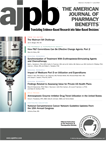Publication
Article
AJPB® Translating Evidence-Based Research Into Value-Based Decisions®
The Walmart $4 Challenge
Author(s):
Programs offering $4 generics lower costs for both payers and healthcare consumers, but these medications should go through the claims system to enable tracking.
Several years ago, Walmart began selling several generic medications for $4. Today, more than 400 generic medications are covered under these types of programs. Although the program was initially aimed at those without a pharmacy benefi t, it did not preclude those with a benefi t who wanted to take advantage of the lower costs. In general, most drug benefi ts required individuals to pay more than $4 for these same drugs. As time went on, in order to remain competitive, several other retail pharmacies also began a similar practice. The reasons behind this program are multifaceted and will not be discussed in this commentary. As I take a look at this ongoing trend of $4 generics, a few questions come to mind.
First, has this practice of low-cost/no-cost generics increased access to medications for those who previously struggled to afford necessary medications? There is some anecdotal evidence that making these medications available at a lower price has had a positive effect on medication adherence for those who have limited or no pharmacy drug benefi ts. This effect seems to make reasonable sense and should not be surprising. There is strong evidence of a correlation between healthcare consumer out-of-pocket costs and medication adherence. Some of the benefi ts of this increased access have been muted since 2006, when
Medicare Part D went into effect. The Medicare drug benefi t gave coverage to 43 million Medicare-eligible individuals who did not previously have a pharmacy benefit.
For the large portion of the American people who have a medication benefi t, however, access has not really changed because the difference in cost is for the most part negligible. Most pharmacy benefi ts put generics in the lowest tier, with a lower cost than brand medications. Often, the cost of generics is $5 or even less in the case of some older medications.
Have the programs offering $4 generics changed healthcare consumers’ buying habits in regard to the use of generics rather than brand medications? It is believed that the marketing of these programs did increase the use of generic medications. However, the true effect cannot be clearly aligned with this marketing effort, as it also correlated with new generics coming on the market. Much of the data are outside of the pharmacy benefi t claims files and therefore are not easily traceable. One Midwestern plan stated that it experienced an increase in generic dispensing and a decrease in average total cost per generic prescription after the initiation of the program.
What we do know is that the widespread advertising of a low-cost alternative caught the attention of several people who previously had not been utilizing available generic medications. This attention in turn created an impetus for conversation between healthcare consumers and their healthcare providers regarding appropriate use of generics. If for no other reason, this is a good outcome. In future columns, I will discuss patients’ and providers’ perceptions of generics.
Have these programs created a drug safety hazard? One of the greatest concerns associated with these types of discount programs is that the medication purchase often does not go through the pharmacy benefi t claim system. Unfortunately, this creates a signifi cant hole in the medication safety net, as safety checks such as drug interactions and allergy checks are not completed.
What lessons can we learn from this experience? I highly support any programs that help improve the healthcare value equation and lower costs for both payers and healthcare consumers. The one caveat to this statement is that we must lower costs without decreasing quality and safety. In regard to the programs offering $4 generics, I think that it is important that these medications still go through the claims system so that appropriate use of medications (whether low cost or not) can be tracked. If I had my way, we also would track over-the-counter medications for allergies, side effects, and interactions.
Health plans and employers should explain to healthcare consumers why it is important that the retail pharmacies put information on $4 generics into their claims systems (ie, to make sure that consumers do not get sick from the medications that they take). We need to continue to innovate to address the problem of runaway healthcare costs. But we should never forget that at the end of the day, it is all about people. Remember, do no harm.







